West Kazakhstan is a beautiful region of the world known for its diverse bird life. The region has various species, ranging from the common house sparrow to the rare and endangered white-headed duck.
West Kazakhstan boasts an impressive variety of habitats, from wetlands to steppes, and this diversity of habitats leads to an abundance of bird species.
In addition to providing critical habitat for birds, the region is also home to several important bird sanctuaries and reserves, such as the Zhana-Aksu Nature Reserve and the Aktau Nature Reserve.
These reserves provide essential habitat for various bird species and are integral to the region’s conservation efforts. With its diverse habitats and bird species, West Kazakhstan is a great place to observe and appreciate the beauty of birds.
22 Birds to Watch in West Kazakhstan
West Kazakhstan is a region of stunning natural beauty and rich biodiversity. The region offers a variety of habitats for birds, from wetlands and lakes to steppes and mountains.
Whether a casual birdwatcher or a serious ornithologist, you will find plenty of species to admire and observe in West Kazakhstan.
Here are 22 birds that you should not miss when visiting this fantastic region.
1. Golden eagle
The golden eagle is a majestic bird of prey found throughout the Northern Hemisphere. It is the most widely distributed species of eagle, belonging to the Accipitridae family.
This species of eagle is distinguished by its impressive size, with a wingspan that can reach up to 8 feet wide. It has a fierce reputation, as it is one of the most powerful birds of prey in the Northern Hemisphere.
The golden eagle is an apex predator, meaning it is at the top of the food chain in its habitat. It has an incredibly sharp sight allows it to spot its prey from far away.
Its diet consists mainly of small mammals such as hares, rabbits, and ground squirrels, but it is also known to hunt and scavenge for carrion. The golden eagle is an iconic symbol of strength and power, highly revered in many cultures.
Ancient Greeks associated the golden eagle with Zeus, the god of gods. In Native American culture, the eagle symbolizes courage and wisdom.
The golden eagle is a protected species in many countries, and it is currently listed as a Near Threatened species by the International Union for Conservation of Nature. Conservation efforts have been implemented to ensure the survival of this species for future generations.
| Kingdom | Animalia |
| Phylum | Chordata |
| Class | Aves |
| Order | Accipitriformes |
| Family | Accipitridae |
| Genus | Aquila |
| Species | A. chrysaetos |
2. Rock Pigeon
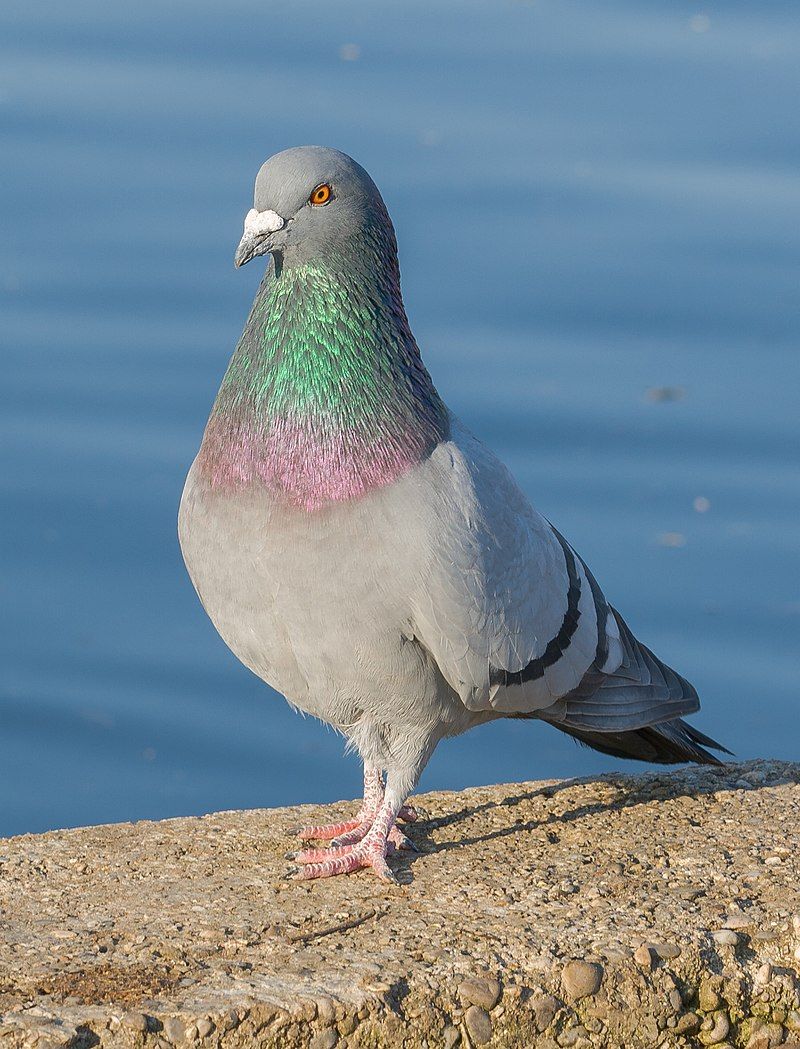
The rock dove, also known as the rock pigeon or common pigeon, is a bird species from the Columbidae family. It is commonly referred to simply as the “pigeon.” This species has been domesticated by humans, resulting in the domestic pigeon.
This species has been introduced to many areas of the world, resulting in the spread of feral pigeon populations. Domestic pigeons have managed to escape and establish themselves in the wild, increasing the number of feral pigeons worldwide.
Pigeons are found in various habitats, from urban to rural areas and even mountain tops. They are very adaptable and can live in a wide range of climates. As a result, they are one of the most widespread bird species in the world.
Pigeons are generally friendly and form large flocks when searching for food. They can also create strong family bonds and often mate for life. Pigeons are omnivorous, feeding on various food sources such as seeds, plants, and insects.
They have also been known to scavenge for food in human settlements. The domesticated form of the rock dove is sometimes kept as a pet due to its friendly nature. Overall, the rock dove, or common pigeon, is a species of bird that has been heavily impacted by human activity.
Domestication has led to the spread of feral populations around the world. They are highly adaptable and can live in a wide variety of habitats. Pigeons have also been kept as pets due to their friendly nature.
| Kingdom | Animalia |
| Phylum | Chordata |
| Class | Aves |
| Order | Columbiformes |
| Family | Columbidae |
| Genus | Columba |
| Species | C. livia |
3. Steppe Eagle
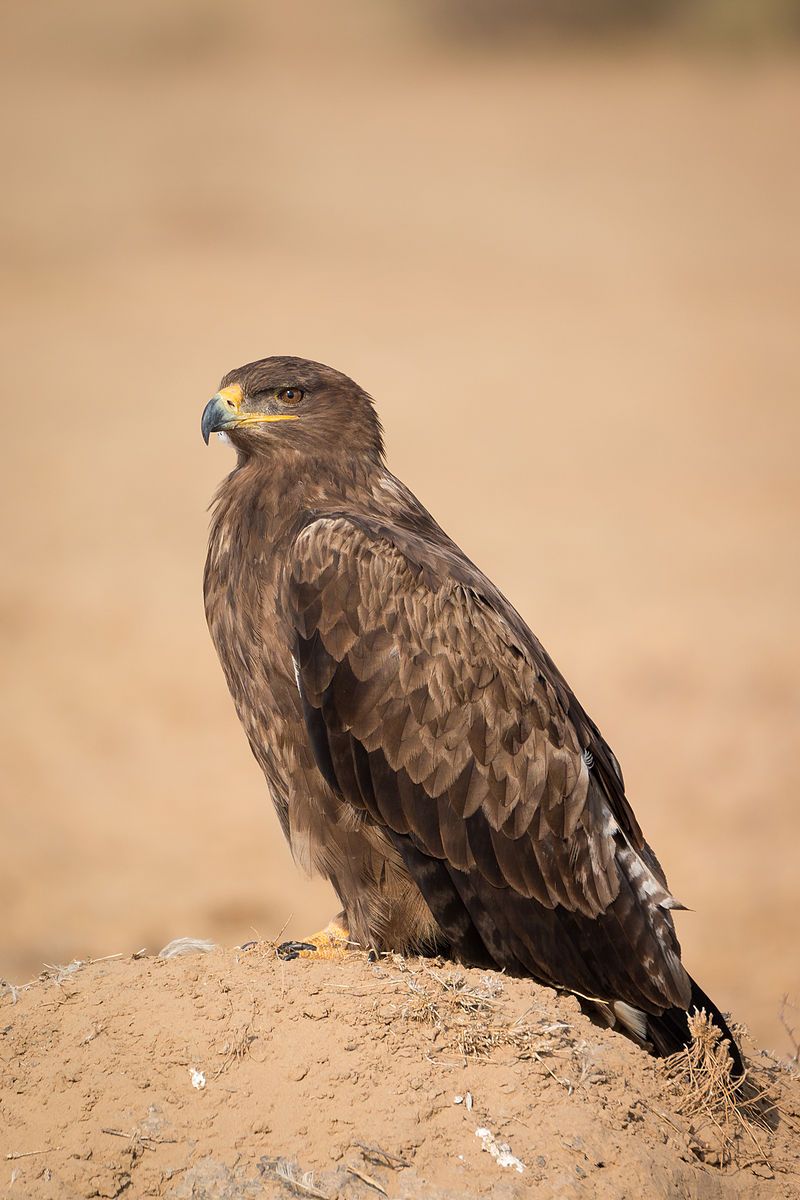
The Steppe Eagle is a large bird of prey belonging to the family Accipitridae. This type of eagle is part of the subfamily Aquilinae, often referred to as “booted eagles” because of their feathered legs.
These feathered legs are a vital characteristic of Aquilinae, with the feathers covering the entire lower leg, distinguishing them from other eagles. The Steppe Eagle is also a large bird of prey with a wingspan reaching up to 7 feet.
This wide wingspan allows the Steppe Eagle to soar above its prey, giving it an advantage when hunting. The Steppe Eagle can be found in open grasslands and semi-arid habitats but is not as common as other eagles.
Despite its rarity, the Steppe Eagle is an impressive sight and an essential part of the food chain in its native habitats.
| Kingdom | Animalia |
| Phylum | Chordata |
| Class | Aves |
| Order | Accipitriformes |
| Family | Accipitridae |
| Genus | Aquila |
| Species | A. nipalensis |
4. Red-crested Pochard
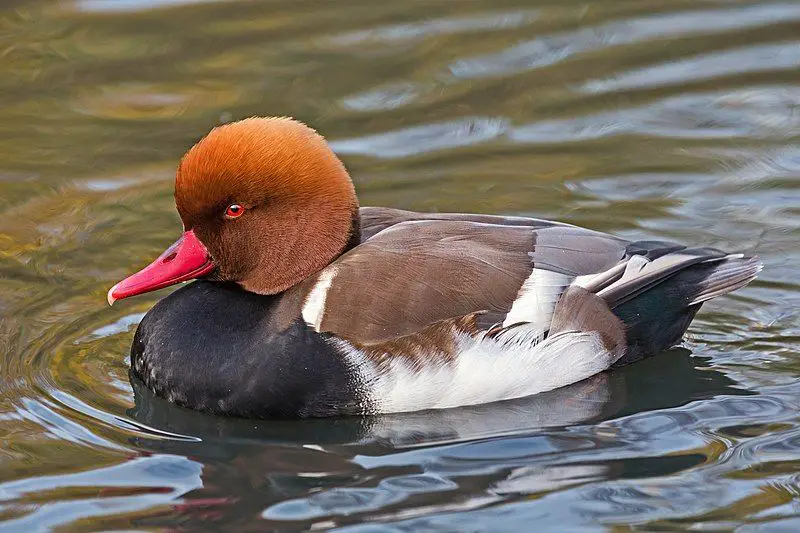
The red-crested pochard is a large species of duck that is found in various regions around the world. These birds have a distinctive red crest on their head, which is part of what gives them their name.
The scientific name for the red-crested pochard is derived from two words in Latin and Greek. The Greek word Netta means “duck”, while the Latin word Rufina means “golden-red”. This reflects the duck’s coloration, which is a reddish-gold hue.
The red-crested pochard can be found in wetlands, lakes, and rivers, and they are a popular species for birdwatching and wildlife photography. They are also an essential food source for many people, as they provide a valuable source of protein.
The red-crested pochard is a species worth protecting, and its scientific name highlights its unique coloration and importance.
| Kingdom | Animalia |
| Phylum | Chordata |
| Class | Aves |
| Order | Anseriformes |
| Family | Anatidae |
| Genus | Netta |
| Species | N. rufina |
5. Common Buzzard
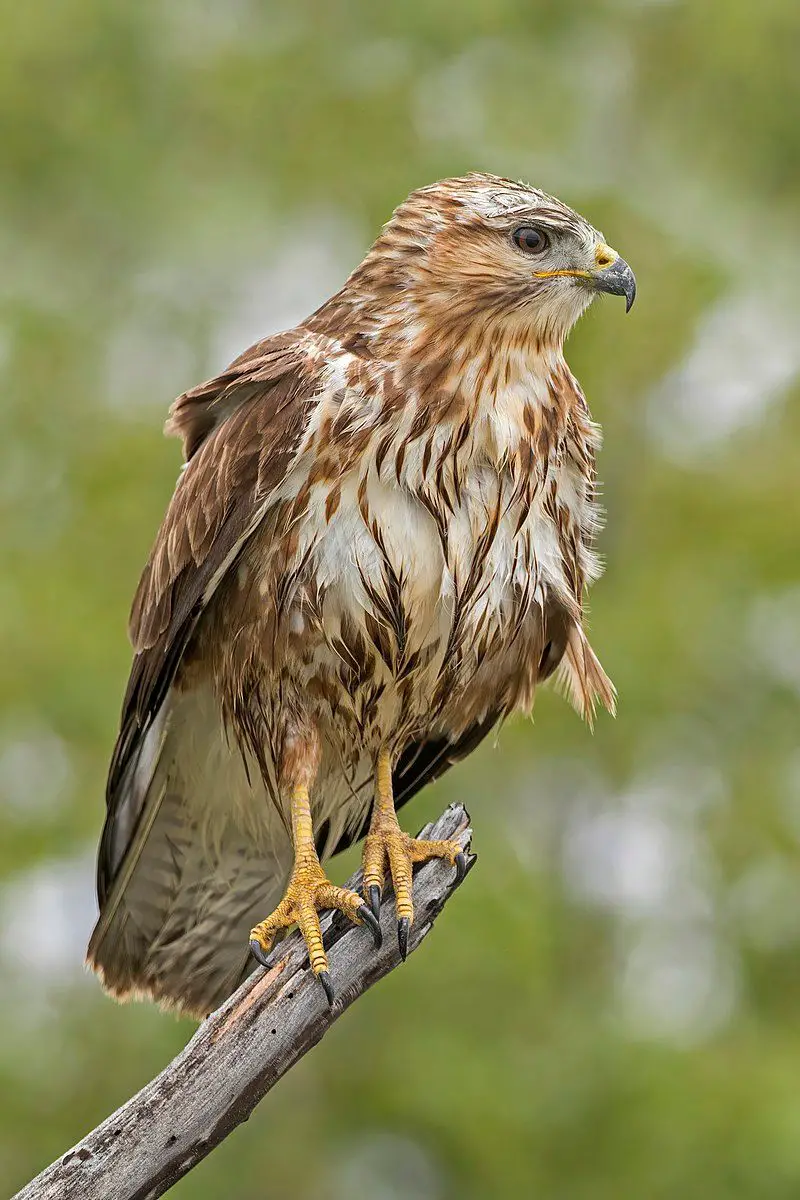
The common buzzard is a bird of prey family member, Accipitridae. It is a medium to large-sized bird found across a wide range of habitats in Europe, from the western edges of Siberia to northwestern China and Mongolia.
It has been observed that the common buzzard has an extensive breeding range across much of the Palearctic, which means that they can breed in almost any open habitat across the region.
This bird species is a strong flier and can travel long distances to feed in areas where food is more abundant.
Common predators are opportunistic feeders, meaning they will take various prey items from the environment, including small mammals, birds, reptiles, amphibians, and invertebrates.
They are also known to scavenge, meaning they will eat carrion or food other animals have discarded. The common buzzard is an essential predator in its habitat, helping to balance populations of smaller animals.
| Kingdom | Animalia |
| Phylum | Chordata |
| Class | Aves |
| Order | Accipitriformes |
| Family | Accipitridae |
| Genus | Buteo |
| Species | B. buteo |
6. White-tailed Eagle
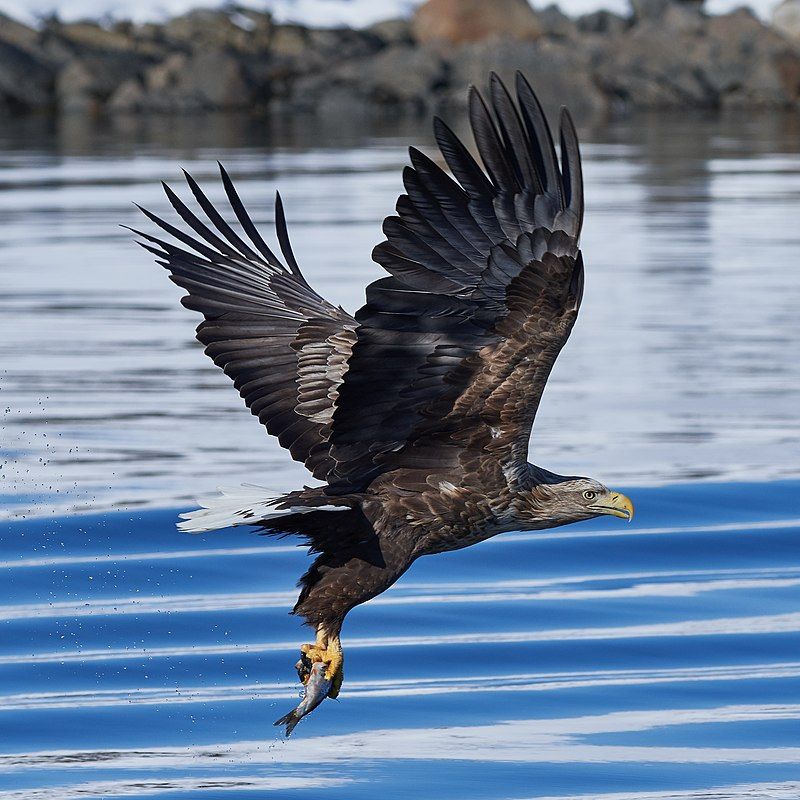
The white-tailed eagle is a large bird of prey found in temperate Eurasia. It is sometimes called a ‘sea eagle’ due to its habitat preference for coastal areas.
This species is a member of the Accipitridae family, which includes several other raptors, such as hawks, kites, and harriers. These birds are diurnal predators, meaning they are active during the day and sleep at night.
White-tailed eagles are highly adaptable birds and are good at surviving in varying climates and habitats. They have various hunting strategies, including scavenging, fishing, and preying on small animals.
The white-tailed eagle is one of the world’s most giant birds of prey, with a wingspan of up to 2.5 meters. It is an impressive sight in the sky, and its presence is often a sign of a healthy environment.
The white-tailed eagle is a protected species whose numbers have increased in recent years. This species is an integral part of the ecosystem, as it helps maintain a balance between predators and prey.
It also serves as a valuable indicator of the environment’s health, and its presence is a sign of a healthy habitat.
| Kingdom | Animalia |
| Phylum | Chordata |
| Class | Aves |
| Order | Accipitriformes |
| Family | Accipitridae |
| Genus | Haliaeetus |
| Species | H. albicilla |
7. Cinereous Vulture
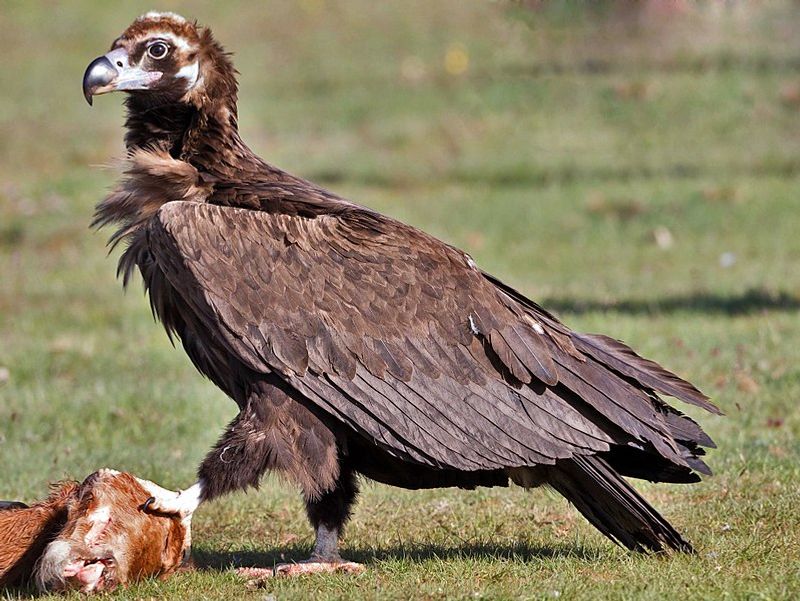
The cinereous Vulture is a large bird of prey that belongs to the Accipitridae family. It is widely distributed in temperate parts of Eurasia, from parts of Europe to the far reaches of Asia. It is also called the black Vulture, monk vulture, and Eurasian black Vulture.
It is one of the world’s most giant birds of prey, with a wingspan of up to 3 meters. It has a distinctive black plumage, with lighter areas on its head and neck. It is an opportunistic feeder, taking advantage of the available resources in its environment.
It can scavenge for carrion but also hunt small mammals, reptiles, and insects. It is an integral part of the ecosystem, helping to keep the environment healthy by keeping populations of other animals in check.
| Kingdom | Animalia |
| Phylum | Chordata |
| Class | Aves |
| Order | Accipitriformes |
| Family | Accipitridae |
| Genus | Aegypius |
| Species | A. monachus |
8. White-headed Duck
The white-headed duck is a small diving duck measuring about 45 cm long. The male has a white head with a black crown, a blue bill, and reddish-grey plumage.
The female has a dark bill, and her plumage is duller than the male’s. The white-headed duck prefers to breed in lakes with open water and dense vegetation at the edge.
This provides the duck with a combination of protection and food, as it can swim in the open water to find food and hide among the vegetation for safety if needed.
The white-headed duck is an endangered species on the IUCN’s Red List of Threatened Species.
The destruction of its natural habitat threatens it, as well as hunting and egg collecting. Conservation efforts have been put in place to protect the species and ensure its survival in the wild.
| Kingdom | Animalia |
| Phylum | Chordata |
| Class | Aves |
| Order | Anseriformes |
| Family | Anatidae |
| Genus | Oxyura |
| Species | O. leucocephala |
9. Egyptian Vulture
The Egyptian Vulture is a small Old World native to the Iberian Peninsula, North Africa, and India. It is the only member of its genus, Neophron, commonly called the white scavenger vulture or pharaoh’s chicken.
The Egyptian Vulture has a unique adaptation that allows it to scavenge for food in various habitats, including deserts, steppes, grasslands, and mountains. The Egyptian Vulture is characterized by its distinctive yellow facial skin and white plumage.
Its body is white, with black patches on its wings and tail. It has a large, hooked beak used to tear flesh from carcasses.
The Egyptian Vulture also feeds on small mammals, insects, and carrion. The Egyptian Vulture is an essential member of its ecosystem, as it helps to break down carbon and keep the environment clean.
Additionally, it is an important indicator species, as its presence can indicate the health of an area’s ecosystem. The Egyptian Vulture is considered to be near threatened due to habitat loss and poaching. Efforts are being made to protect and conserve this species.
| Kingdom | Animalia |
| Phylum | Chordata |
| Class | Aves |
| Order | Accipitriformes |
| Family | Accipitridae |
| Genus | Neophron |
| Species | N. percnopterus |
10. Black-winged Stilt
The black-winged stilt is a type of wading bird that belongs to the avocet and stilt family. It is found worldwide and is easily recognized due to its long legs and distinctive black wings. The scientific name for this species is H.
Himantopus is used to identify a single type of bird seen almost everywhere. The black-winged stilt is a highly adaptable species that can survive in various habitats, from wetlands to coastal areas.
It is a social bird that often forages in small groups and can be seen perched on tall vegetation or flying for food.
The black-winged stilt is a crucial part of wetland ecosystems, as it helps to maintain the balance of organisms by providing food for predators such as fish and other birds.
It also plays a vital role in maintaining the environment’s health by controlling insect populations and providing essential nutrients to the soil.
| Kingdom | Animalia |
| Phylum | Chordata |
| Class | Aves |
| Order | Charadriiformes |
| Family | Recurvirostridae |
| Genus | Himantopus |
| Species | H. himantopus |
11. Red-breasted Goose
The red-breasted goose is a species of goose that is found in Eurasia. It is easily identified by its striking red markings, which are located on its chest and neck. The International Union for Conservation of Nature (IUCN) classifies this goose species as vulnerable.
This means that the population of the red-breasted goose is declining and is at risk of becoming extinct. Conservationists have identified several threats to the species, such as hunting, habitat loss, and climate change.
Hunting is a significant threat, as these geese are hunted for their meat and feathers. Habitat loss is also a considerable issue, as their preferred habitats are being destroyed due to human development.
Finally, climate change is having a huge impact, as it is changing the availability of food sources and causing an increase in extreme weather events.
All of these threats are causing the population of the red-breasted goose to decline, leading to its vulnerable classification.
Conservationists are now working to protect this species and its habitats to ensure its survival.
| Kingdom | Animalia |
| Phylum | Chordata |
| Class | Aves |
| Order | Anseriformes |
| Family | Anatidae |
| Genus | Branta |
| Species | B. ruficollis |
12. Gadwall
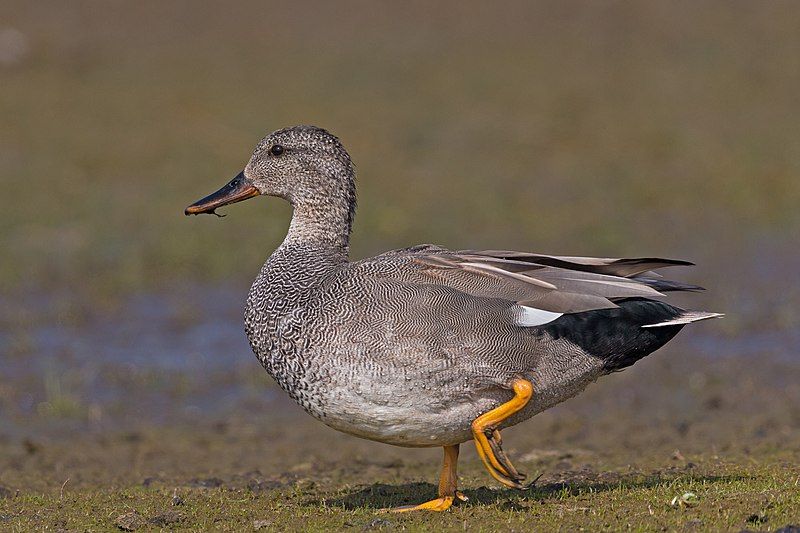
The gadwall is a species of dabbling duck belonging to the family Anatidae. It is a medium-sized duck with a length of approximately 19 inches and a wingspan of around 28 inches. The gadwall is grey, with a black head and white patch on the wing.
The male has a grey body, black head and breast, and white patches on the wings. The female is brown with a white patch on the wing. Gadwalls are found in many parts of the world, including North America, Europe, Asia, and Africa.
They are especially abundant in wetlands, such as marshes, ponds, and lakes. They feed on aquatic vegetation, insects, and small fish. They are often seen in large flocks, flying in V-shaped formations.
Gadwalls are social birds, often forming monogamous pairs and nesting in small colonies. They nest on the ground, usually near the water’s edge. The female lays an average of eight to ten eggs, which both parents incubate. The young fledge within four weeks.
The gadwall is a widespread species with a stable population. It is currently listed as least concern on the IUCN Red List of Threatened Species.
| Kingdom | Animalia |
| Phylum | Chordata |
| Class | Aves |
| Order | Anseriformes |
| Family | Anatidae |
| Genus | Mareca |
| Species | M. strepera |
13. Ferruginous Duck
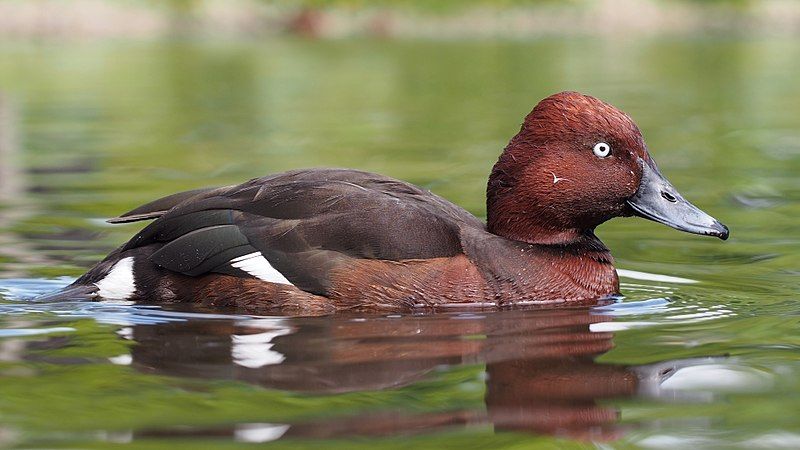
The ferruginous duck is an impressive bird species found in Eurasia. It is also called a ferruginous pochard, a common white-eye or white-eyed pochard. This medium-sized diving duck has a scientific name derived from Greek terms.
The first part of the name, Lithuania, is an unidentified seabird mentioned by authors like Hesychius and Aristotle.
The second part, nyrok, is the Russian word for duck. The ferruginous duck is usually brownish-grey, with a white eye-ring and a white patch on the back of the head. Its bill is also typically orange-yellow, and its legs and feet have a dark slate color.
This duck species is usually found in wetlands, such as shallow lakes and marshes, and it is also sometimes seen in agricultural fields. The ferruginous duck feeds mainly on aquatic plants and insect larvae, and it usually dives beneath the water to do so.
This species of duck is known for its intense vocalizations, and its courtship display includes a “head-throwing” behavior where the bird throws its head back and forth in an impressive manner.
The ferruginous duck is a species of conservation concern, as its population is in decline due to loss of habitat and human disturbance.
Conservation efforts are being taken to help protect this species of duck, and it is hoped that its population will be able to increase in the future.
| Kingdom | Animalia |
| Phylum | Chordata |
| Class | Aves |
| Order | Anseriformes |
| Family | Anatidae |
| Genus | Aythya |
| Species | A. nyroca |
14. Greater Flamingo
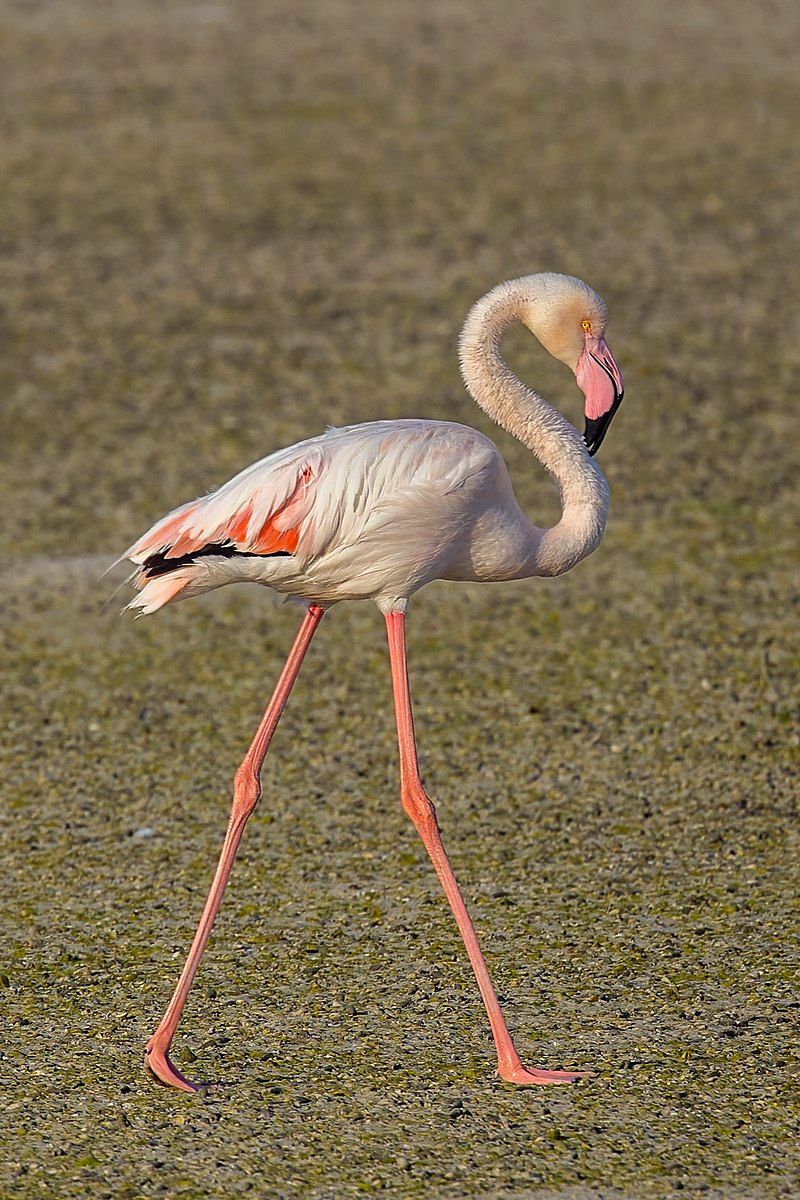
The greater flamingo is a species of flamingo found in numerous regions of the world. It is the most widespread and significant species of its family and is commonly found in the Old World.
This species of flamingo is native to Northern and Sub-Saharan Africa, the Indian Subcontinent, the Middle East, the Levant, the Persian Gulf, the Gulf of Aden, the Red Sea, and the Mediterranean countries of Southern Europe.
The greater flamingo is an impressive bird species with a wingspan reaching five feet long.
Its plumage is often pink, with a white head and neck, and its long legs can be up to two feet long. This species is an omnivore, which eats both plant and animal material.
It feeds on algae, small insects, mollusks, crustaceans, and even small vertebrates. The greater flamingo inhabits both brackish and saltwater wetlands. During the breeding season, they form large colonies of up to a hundred thousand individuals.
They nest in shallow water and lay their eggs on a mud mound.
The chicks are altricial, meaning they are born helpless and require parental care. The greater flamingo has a wide range, but its population is declining in many areas due to habitat destruction, pollution, and human disturbance.
It is listed as a species of most minor concern by the IUCN, but it is still at risk due to its threats. Conservation efforts are necessary to ensure the future of the greater flamingo and its wetland habitats.
| Kingdom | Animalia |
| Phylum | Chordata |
| Class | Aves |
| Order | Phoenicopteriformes |
| Family | Phoenicopteridae |
| Genus | Phoenicopterus |
| Species | P. roseus |
15. Glossy Ibis
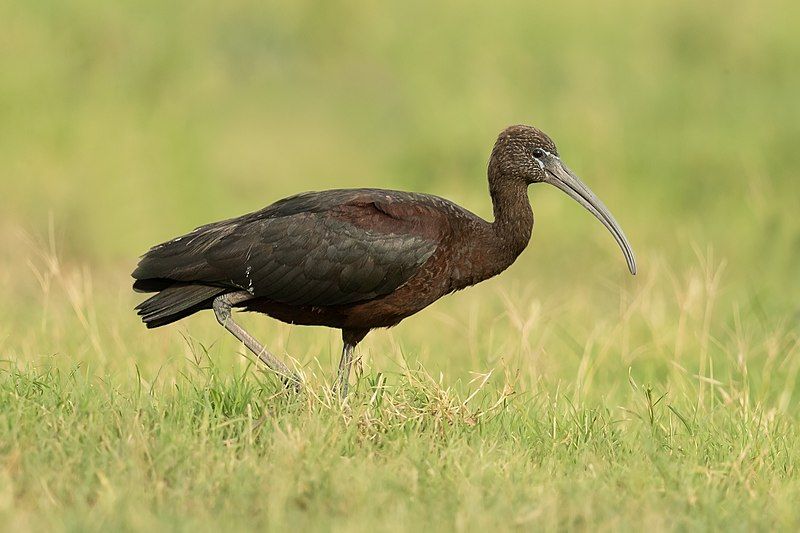
The Glossy Ibis is a species of water bird belonging to the order Pelecaniformes and the family Threskiornithidae, which also includes ibises and spoonbills.
Its scientific name, Plegadis falcinellus, is derived from Ancient Greek and Latin words meaning “sickle” and likely refers to the distinctive curved shape of the bird’s bill.
The glossy ibis has a long, curved, and pointed bill that it uses to find food in shallow water, like marshes and mudflats. Its bill also reaches into water plants to pick up food, such as fish, insects, worms, mollusks, and crustaceans.
The glossy ibis is a migratory species, with populations often traveling to other parts of the world. It can be found in Europe, Africa, the Middle East, Asia, and parts of the United States and Canada.
The glossy ibis is a medium-sized bird with a wingspan of about 60 centimeters. Its plumage is usually a shiny dark brown, though a few populations may be slightly lighter or darker.
| Kingdom | Animalia |
| Phylum | Chordata |
| Class | Aves |
| Order | Pelecaniformes |
| Family | Threskiornithidae |
| Genus | Plegadis |
| Species | P. falcinellus |
16. Black Stork
The black stork is a large bird belonging to the family Ciconiidae, one of the most diverse and widespread families of birds. Swedish scientist Carl Linnaeus first documented it in the 10th edition of his landmark work, Systema Naturae.
This comprehensive compendium of zoological knowledge, first published in 1758, is considered one of the most influential and essential works in the history of natural science.
The black stork is a large bird, ranging from 75–90 cm in length, with a wingspan of approximately 150 cm.
It has a distinctive black plumage, a white belly, and long red legs. It is primarily a scavenger, feeding on carrions, fish, amphibians, reptiles, small mammals, and invertebrates. It is a solitary bird and is usually seen alone or in pairs.
Its habitat varies, including wetlands, forests, grasslands, and agricultural areas. The black stork is listed as a species of most minor concern by the IUCN, as its population is stable and widespread.
Conservation efforts have protected the species from hunting and habitat destruction in many areas. Despite this, its population is still threatened by the destruction of wetlands, illegal hunting, and the use of pesticides.
| Kingdom | Animalia |
| Phylum | Chordata |
| Class | Aves |
| Order | Ciconiiformes |
| Family | Ciconiidae |
| Genus | Ciconia |
| Species | C. nigra |
17. Lesser Kestrel
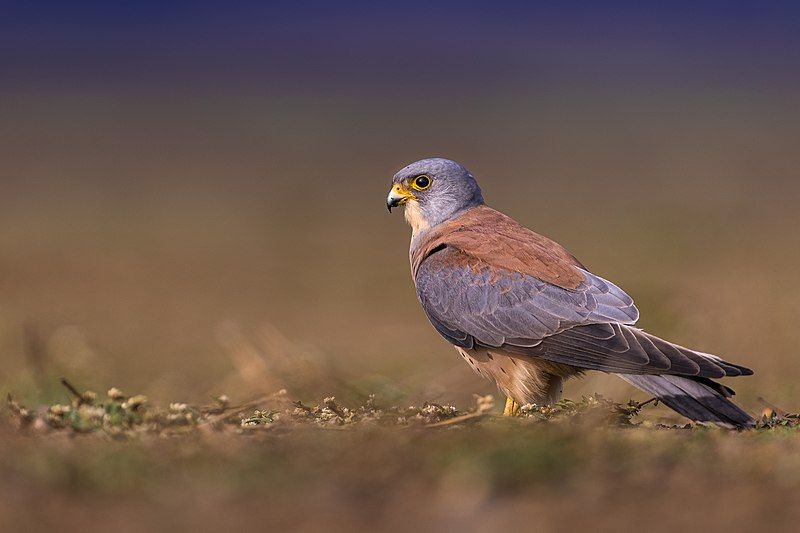
The lesser kestrel is a small species of falcon native to the Mediterranean region. It is known to breed in the Mediterranean, Afghanistan, Central Asia, China, and Mongolia.
During the summer, the lesser kestrel will migrate to Africa, Pakistan, India, and Iraq for the winter season. This species is rare in areas north of its usual breeding range and is declining in its European range.
The lesser kestrel is a small bird of prey, typically measuring between 28 and 32 cm in length with a wingspan of up to 60 cm. The plumage is pale grey on the upperparts, with a white head and chest.
The wings are brownish-grey, while the tail is brownish-black with white corners. The facial markings include a black malar stripe, white supercilium, yellow cere, and eyes. This species mainly inhabits open grassy plains and agricultural landscapes.
It will feed on small insects and rodents, typically hunting from a perch or the air. Its diet usually consists of grasshoppers, beetles, and small rodents. It may also feed on lizards, small birds, and snakes.
The lesser kestrel is listed as Near Threatened on the IUCN Red List. The primary threat to this species is habitat destruction, which is believed to have declined by 20-30% over the past three generations.
Other threats include illegal hunting, pesticide use, and competition with different bird species. Conservation efforts are necessary to protect this species and help prevent its decline.
| Kingdom | Animalia |
| Phylum | Chordata |
| Class | Aves |
| Order | Falconiformes |
| Family | Falconidae |
| Genus | Falco |
| Species | F. naumanni |
18. Swan Goose
The swan is a large goose species known for its migratory patterns and natural breeding range. It is native to inland Mongolia, Northeast China, and the Russian Far East, and during the winter months, it migrates to central and eastern China.
This goose species is known for its distinctive white feathers, black beak, and majestic flight patterns. The swan goose is often seen in flocks, and they may travel miles searching for food and water.
They are known for their mighty wingspan that helps them quickly soar through the air. The swan goose is an integral part of the local ecology, as it helps maintain the balance between different species of birds in an area.
It also helps to spread seeds and nutrients through its migratory patterns, which helps to ensure that the local environment remains healthy. Additionally, the swan goose is an essential food source for some local communities, providing a valuable source of sustenance.
| Kingdom | Animalia |
| Phylum | Chordata |
| Class | Aves |
| Order | Anseriformes |
| Family | Anatidae |
| Genus | Anser |
| Species | A. cygnoides |
19. Great Bustard
The Great Bustard is a large bird in the Bustard family. It is the only living member of the genus Otis, which makes it a unique species. The great bustard is found in various habitats, such as open grasslands and farmland.
It can be found in many regions, including northern Morocco, South and Central Europe, and temperate Central and East Asia. The great bustard is a relatively large bird, with males typically weighing up to 17 pounds.
Its wingspan can reach up to 7 feet, allowing it to soar quickly. The plumage of a great bustard is typically gray, with white or pale patches on its wings and head.
It is an omnivorous species, feeding on various insects, small mammals, and some plant material. The great bustard is a species of conservation concern, as its population has been declining due to the destruction of its natural habitat.
It is also threatened by hunting and other human activities. As a result, conservation efforts are in place to protect this species and its habitat. Overall, the great bustard is an incredible species with a wide distribution.
It is an integral part of the ecosystem, and its population must be protected and preserved.
| Kingdom | Animalia |
| Phylum | Chordata |
| Class | Aves |
| Order | Otidiformes |
| Family | Otididae |
| Genus | Otis |
| Species | O. tarda |
20. Eurasian Scops Owl
The Eurasian scops owl is a small bird in the Strigidae family, commonly known as the European scops owl or simply the scops owl. It is found throughout southern Europe, from the east of the continent to south Siberia and the western Himalayas.
This species is migratory, so it spends its winter season in Africa south of the Sahara. The Eurasian scoop owl is a small bird with a 16 to 18-cm body length.
Its plumage is light brown, with a light gray underside, and it has a white facial disk, yellow eyes, and a black beak. The Eurasian scoop owl is a nocturnal predator, hunting insects and other small animals in the evening.
It is also a vocal bird, producing a variety of calls, including a loud, prolonged hoot. Although it is a common species, it is still threatened by habitat destruction and illegal hunting. Conservation efforts are needed to ensure the survival of this species.
| Kingdom | Animalia |
| Phylum | Chordata |
| Class | Aves |
| Order | Strigiformes |
| Family | Strigidae |
| Genus | Otus |
| Species | O. scops |
21. Garganey
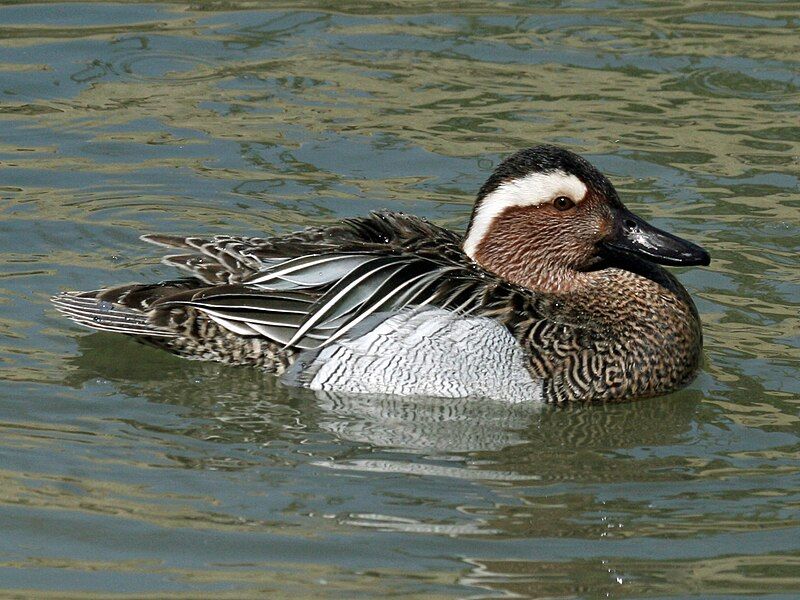
The garganey is a species of small dabbling duck found across much of Europe and the Palearctic region. This bird is strictly migratory, meaning that the species’ entire population moves south for the winter.
This includes traveling to southern Africa, India, Bangladesh and Australasia. During the winter months in the Northern Hemisphere, large flocks of garganey ducks can be seen in these areas.
This unique species is an excellent example of the long-distance migratory behavior of many waterfowl species.
| Kingdom | Animalia |
| Phylum | Chordata |
| Class | Aves |
| Order | Anseriformes |
| Family | Anatidae |
| Genus | Spatula |
| Species | S. querquedula |
22. Whooper Swan
The whooper swan is a large species found in the northern hemisphere. It is also known as the common swan and is one of the most giant birds found in the region.
The Eurasian counterpart of the North American trumpeter swan shares many similarities with its American counterpart.
The whooper swan is also the type species for the genus Cygnus, a taxonomy of birds that includes several species of swans. This makes the whooper swan a critical species in understanding the evolution and biology of swans in general.
The whooper swan is a striking bird with its large size and white feathers. Its eyes are yellow, and its bill is black. It has a long neck and a steady flight, often flying in V-formations.
The whooper swan is a powerful and graceful bird and is an elegant sight in its natural habitat. The whooper swan is common in wetland areas, such as rivers, lakes, and marshes. It is an omnivore, eating a variety of plant and animal matter.
It is also a migratory species, traveling long distances between its summer and wintering grounds. Its call is a loud, trumpeting sound, hence its name.
Overall, the whooper swan is a beautiful and impressive species, being the Eurasian counterpart of the North American trumpeter swan and the type species for Cygnus. It is a powerful, graceful bird and a common sight in wetland areas.
Its loud, trumpeting call is a distinctive sound of the northern hemisphere.
| Kingdom | Animalia |
| Phylum | Chordata |
| Class | Aves |
| Order | Anseriformes |
| Family | Anatidae |
| Genus | Cygnus |
| Species | C. cygnus |
Conclusion
The birds of West Kazakhstan are a diverse and beautiful species inhabiting the region. Many of these species are declining in population due to human activities, such as habitat destruction, poaching, and climate change.
Despite these threats, the birds of West Kazakhstan remain an essential part of the region’s natural ecosystem and should be protected to ensure their continued existence.
Conservation efforts, such as habitat protection, regulation of hunting, and public awareness campaigns, could help to ensure the future of the birds of West Kazakhstan.